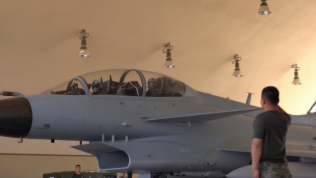By Le Shui
The US Department of Defense (DoD) stated in the recently released first National Defense Industrial Strategy report that the US defense industry production speed is unable to meet the global demand. Furthermore, the report bloated the so-called China threats, saying that as China rises as a global industrial powerhouse, its defense industry has significantly surpassed the production capacity of the US, resulting in US arms industry struggling to keep up with China.
This statement by the DoD appears to be self-incriminating, but it actually serves a hidden agenda. The report proposed that to cope with the so-called China threats, the US Congress should increase an appropriation of billions of US dollars to the national defense industry to build new factories for producing artillery shells and other ammunition in preparation for possible future military conflicts. It can be seen that the real purpose of the DoD manufacturing and peddling military anxiety is to feed their arms dealers by employing the so-called "China threat theory".
It is known that the US possesses the world's most powerful armed forces and also tops the list in terms of global military expenditures. As is shown in the report of the Stockholm International Peace Research Institute (SIPRI), the US defense budget in 2022 exceeded USD 877 billion, ranking first in the world, which surpassed the total volume of the following 10 countries behind it and amounted to three times the defense budget of China that year. Nonetheless, such huge military spending still failed to satisfy the appetite of the US arms dealers. The US defense budget reached another record of USD 886 billion in FY2024, representing 3.2% of its gross domestic product and 47% of the federal discretionary spending. In tandem with this, the US federal government's fiscal deficits continue to climb, which had grown to USD 1.695 trillion by 23% in 2023 alone. The massive fiscal deficits echo the record-high defense budgets, serving as the most accurate portrayal of the US government's image of building up military power recklessly.
According to relevant statistics, the US started 201 of 248 armed conflicts that happened in 153 regions worldwide from the end of World War II to 2001. The warlike US has never lacked the ability nor motivation to wage wars. The military-industrial complex is just the biggest engine of the US war machine.
Early in 1961, former US President Dwight David Eisenhower apprehensively warned in his farewell speech that the total influence of the military-industrial complex composed of military institutions and arms dealers had felt in every office of the government. Sixty-three years later, however, the military-industrial complex has grown unabated in its influences and ballooned into a monster that brews wars by shaping government decisions. The Costs of War budget report released by Brown University shows that since the launch of the Afghanistan War in 2001, the US military expenditure has surpassed USD 14 trillion cumulatively, of which more than one-third has gone into the hands of US military-industrial enterprises. Especially after the outbreak of the Ukraine crisis, US arms dealers have reaped huge profits. According to the estimation of the US think tank Foundation for Defense of Democracies, the US defense enterprises have captured military orders worth almost USD 22 billion thanks to the Ukraine crisis.
Driven by the interests of the military-industrial complex, the US constantly creates conflicts and opponents in the world. The current world is witnessing the persistent dragging-on of the Ukraine crisis, continuous escalation of the Palestinian- Israeli conflict and intensified atmosphere on the Korean Peninsula. As two major countries in the world, China and the US should jointly shoulder the responsibility of maintaining world peace and stability. However, the US has always capitalized on regional conflicts to a mass wealth by adding fuel to the fire. This time, the US unjustifiably exaggerates China's defense industrial capacity and wantonly clamors for the so-called "China threat" theory in the release of the National Defense Industrial Strategy report, in a bid to make excuses for winning more defense budgets.
US economist John Kenneth Galbraith pointed out in his book The New Industrial State that the military industry groups determine the weaponry development and research, as well as procurement and deployment, or the opponents of the US. The war-fed military-industrial complex has gradually hijacked the foreign policies of the US government, incurring numerous opponents and repeated conflicts globally for the country.
To pursue peace and development has been the consensus of all Asia-Pacific countries and also a firm choice of China. China has no intention of engaging in arms races nor becoming an imaginary enemy of the US. The US government should earnestly reflect on its foreign policies, avoid being kidnapped and disturbed by individual interest groups, strive to promote world peace and stability, and refrain from introducing regional confrontation and armed conflicts into the Asia-Pacific region.
Editor's note: Originally published on china.com.cn, this article is translated from Chinese into English and edited by the China Military Online. The information and opinions in this article do not necessarily reflect the views of eng.chinamil.com.cn.









